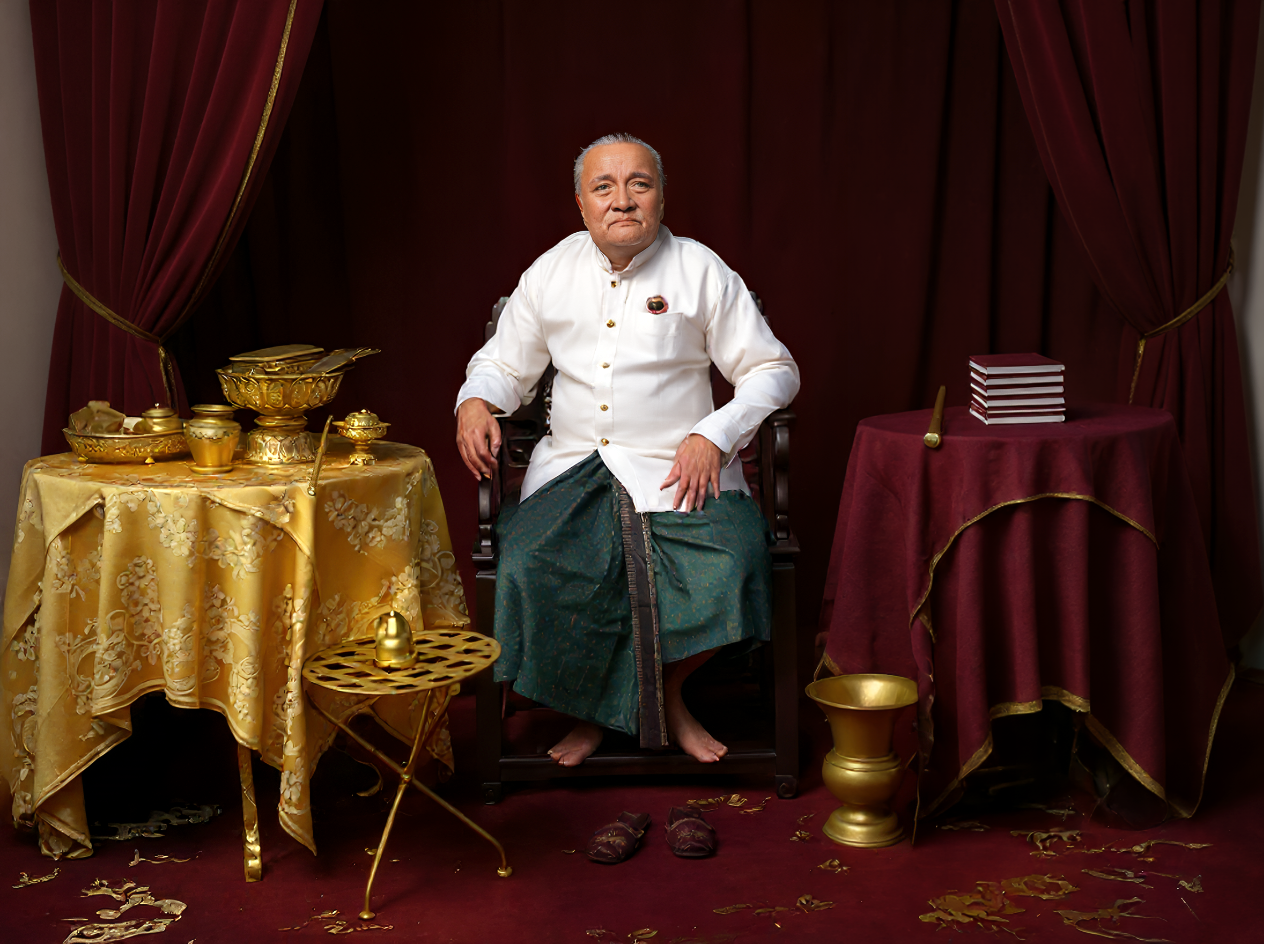เจ้าพระยาวิเชียรคีรี (เม่น ณ สงขลา) เจ้าเมืองสงขลาคนที่ ๖ (พ.ศ. ๒๔๐๘–๒๔๒๗ / ค.ศ. 1865–1884)
เจ้าพระยาวิเชียรคีรี (เม่น ณ สงขลา) เจ้าเมืองสงขลาคนที่ ๖ (พ.ศ. ๒๔๐๘–๒๔๒๗ / ค.ศ. 1865–1884)
เจ้าพระยาวิเชียรคีรี (เม่น ณ สงขลา) เจ้าเมืองสงขลาคนที่ ๖ (พ.ศ. ๒๔๐๘–๒๔๒๗ / ค.ศ. 1865–1884)
คอลเล็กชันภาพถ่ายที่ได้รับการบูรณะด้วยเทคโนโลยี AI ชุดนี้ คือรูปของเจ้าพระยาวิเชียรคีรี (เม่น ณ สงขลา) ถือเป็นภาพเก่าแก่มาก ลำดับต้น ๆ ของสงขลา ที่ได้รับภาพต้นฉบับมาจากคุณธนชัย กปิลกาญจน์
เจ้าพระยาวิเชียรคีรี (เม่น) เกิดวันเสาร์ ปีกุน พุทธศักราช ๒๓๕๘ เป็นบุตรของพระยาวิเศษภักดีศรีสมุทรสงคราม (เถี้ยนจ๋ง) เจ้าเมืองสงขลาลำดับที่ ๓
เดิมได้ถวายตัวเป็นมหาดเล็กในพระบาทสมเด็จพระนั่งเกล้าเจ้าอยู่หัว รัชกาลที่ ๓ ทรงโปรดเกล้าฯ ให้เป็นนายจ่าเรศมหาดเล็กหลวง ต่อมาได้เลื่อนขึ้นเป็นพระสุนทรานุรักษ์ ผู้ช่วยราชการเมืองสงขลา พระยาสุนทรานุรักษ์ จนกระทั่งปี ๒๔๑๕ ได้เลื่อนขึ้นเป็นเจ้าพระยาวิเชียรคีรี ต่อมาปี ๒๔๑๖ ได้รับพระราชทานตราปฐมจุลจอมเกล้า
เมื่อปี ๒๔๐๘ เจ้าพระยาวิเชียรคีรี (บุญสังข์) ผู้เป็นอาถึงแก่อนิจกรรม ทรงโปรดเกล้าฯ ให้พระยาสุนทรานุรักษ์ (เม่น) ผู้ช่วยราชการเมืองสงขลา เป็นพระยาวิเชียรคีรี ผู้สำเร็จราชการเมืองสงขลา ถือศักดินา ๕,๐๐๐ ไร่ ถือเป็นเจ้าเมืองสงขลาลำดับที่ ๖ ในสายตระกูล ณ สงขลา
เมื่อพระบาทสมเด็จพระจอมเกล้าเจ้าอยู่หัว เสด็จประพาสเมืองสงขลา มีพระบรมราชโองการโปรดเกล้าฯ พระราชทานเงิน ๓๗ ชั่งเศษ ให้เจ้าพระยาวิเชียรคีรี (เม่น) รับสนองพระบรมราชโองการ เป็นแม่กองควบคุมการสร้างพระเจดีย์บนยอดเขาตังกวน บูรณปฏิสังขรณ์ให้สูงใหญ่กว่าเก่า
เจ้าพระยาวิเชียรคีรี (เม่น) สมรสกับท่านผู้หญิงสุทธิ์ บุตรพระยารัตนโกษา (บุญเกิด) มีบุตรธิดา ๔ ท่าน คือ
๑. พระยาสุนทรานุรักษ์ (เนตร์)
๒. ท่านกลิ่น
๓. ท่านกุหลาบ
๔. ท่านปั้น
และมีบุตรธิดาด้วยภรรยาอื่นอีกหลายท่าน ได้แก่
๑. ท่านตง
๒. ท่านรื่น
๓. ท่านเริง
๔. ท่านเปรม
๕. ท่านคล้าม
๖. ท่านอาด
๗. ท่านจ้อย
หลังจากการถึงแก่อนิจกรรมของพระยาสุนทรานุรักษ์ (เนตร์) บุตรชายซึ่งถูกวางตัวให้เป็นผู้สืบตระกูล เมื่อปี ๒๔๒๕ เจ้าพระยาวิเชียรคีรี (เม่น) ก็เริ่มมีอาการป่วย อันเนื่องมาจากความเสียใจ และถึงแก่อนิจกรรมเมื่อวันที่ ๗ มิถุนายน ๒๔๒๗
สำหรับการแต่งกายของเจ้าพระยาวิเชียรคีรี (เม่น ณ สงขลา)
ดร.สุรัตน์ จงดา ผู้ช่วยอธิการบดี สถาบันบัณฑิตพัฒนศิลป์ ได้ให้ข้อมูลไว้ว่า
การนุ่งผ้ายาวผู้ชายมี ๒ แบบ
นุ่งลอยชาย คือนุ่งแบบโจงแต่ไม่สอดเหน็บหลัง ปล่อยหาง แล้วยกผ้าเหน็บหน้าให้ชายผ้าอยู่ข้างหน้า บางทีลากพื้น เป็นการนุ่งแบบไม่ทางการ ใส่สบายอยู่บ้าน หรือออกเดินตามถนน มีผ้าพาดไหล่
นุ่งจีบ เป็นการนุ่งผ้ายาวจับจีบหน้าให้เรียบร้อย มีจีบชายพกข้างและจีบหน้า นุ่งอย่างเดียวกับนุ่งจีบสตรี ผ้าที่ใช้จะเป็นผ้าอย่างดี เช่น ผ้าลายอย่าง หรือผ้ายก ผ้าลายอย่างจะลงแป้งและขัดผ้าให้มัน อัดจีบไว้แล้วมัดผ้า อบร่ำ เมื่อจะใช้แก้เชือก จับผ้าที่จีบไว้นุ่งได้เลย นุ่งจีบเป็นการนุ่งอย่างทางการมาแต่สมัยอยุธยา แต่เดิมมักไม่สวมเสื้อ นุ่งจีบคาดเข็มขัดทองหัวเข็มขัดทองประดับเพชรพลอย ดังพระบรมรูปรัชกาลที่ ๑–๓ ที่ปราสาทพระเทพบิดร ซึ่งพระบรมรูปนุ่งพระภูษาแบบนี้ หรือภาพเจ้านายขุนนางสมัยรัชกาลที่ ๒–ต้นรัชกาลที่ ๔ ภายหลังในสมัยรัชกาลที่ ๔ ทรงให้ขุนนางเจ้านายใส่เสื้อเข้าเฝ้า จึงมีการใส่เสื้อพร้อมนุ่งจีบด้วย ประเพณีนุ่งจีบผู้ชายสิ้นสุดลงประมาณสมัยรัชกาลที่ ๔
ซึ่งเราจะเห็นได้ว่า ในรูปนี้ เจ้าพระยาวิเชียรคีรี (เม่น ณ สงขลา) แต่งตัวแบบผู้ชายโบราณ สมัยต้นรัตนโกสินทร์
Chao Phraya Wichien Khiri (Men Na Songkhla), the 6th Governor of Songkhla (1865–1884)
This collection of photographs restored using AI technology features an image of Chao Phraya Wichian Khiri (Men Na Songkhla) [เจ้าพระยาวิเชียรคีรี (เม่น ณ สงขลา)], considered one of the earliest known photographs from Songkhla. The original image was kindly provided by Mr. Thanachai Kapilakan [ธนชัย กปิลกาญจน์].
Chao Phraya Wichian Khiri (Men) [เจ้าพระยาวิเชียรคีรี (เม่น)] was born on a Saturday in the Year of the Pig, 1815 (B.E. 2358). He was the son of Phraya Wiset Phakdi Si Samut Songkhram (Thian Chong) [พระยาวิเศษภักดีศรีสมุทรสงคราม (เถี้ยนจ๋ง)], the third governor of Songkhla.
He first entered royal service as a page in the reign of King Nangklao (Rama III) [พระบาทสมเด็จพระนั่งเกล้าเจ้าอยู่หัว รัชกาลที่ ๓] and was appointed Nai Cha Ret (Chief Page of the Royal Pages). He was later promoted to Phra Suntharanu Rak [พระสุนทรานุรักษ์], Assistant Governor of Songkhla, then Phraya Suntharanu Rak [พระยาสุนทรานุรักษ์], before being elevated in 1872 (B.E. 2415) to Chao Phraya Wichian Khiri [เจ้าพระยาวิเชียรคีรี]. In 1873 (B.E. 2416), he was granted the insignia of the Most Illustrious Order of Chula Chom Klao, First Class [ตราปฐมจุลจอมเกล้า].
In 1865 (B.E. 2408), upon the death of Chao Phraya Wichian Khiri (Bunsang) [เจ้าพระยาวิเชียรคีรี (บุญสังข์)], his uncle, King Mongkut [พระบาทสมเด็จพระจอมเกล้าเจ้าอยู่หัว] appointed Phraya Suntharanu Rak (Men) [พระยาสุนทรานุรักษ์ (เม่น)], then serving as Assistant Governor of Songkhla, to the position of Phraya Wichian Khiri [พระยาวิเชียรคีรี], Governor of Songkhla, holding a sakdina (land rank) of 5,000 rai. He was the sixth governor of Songkhla from the Na Songkhla family line.
When King Mongkut [พระบาทสมเด็จพระจอมเกล้าเจ้าอยู่หัว] visited Songkhla, His Majesty granted more than 37 changin silver to Chao Phraya Wichian Khiri (Men) [เจ้าพระยาวิเชียรคีรี (เม่น)] to oversee the construction of the pagoda on the summit of Tang Kuan Hill, restoring and enlarging it to be taller than before.
Chao Phraya Wichian Khiri (Men) [เจ้าพระยาวิเชียรคีรี (เม่น)] married Than Phuying Sutthi [ท่านผู้หญิงสุทธิ์], daughter of Phraya Rattanakosa (Bunkerd) [พระยารัตนโกษา (บุญเกิด)], and they had four children:
Phraya Suntharanu Rak (Net) [พระยาสุนทรานุรักษ์ (เนตร์)]
Than Klin [ท่านกลิ่น]
Than Kulab [ท่านกุหลาบ]
Than Pan [ท่านปั้น]
He also had several other children by other wives:
Than Tong [ท่านตง]
Than Ruin [ท่านรื่น]
Than Roeng [ท่านเริง]
Than Prem [ท่านเปรม]
Than Klam [ท่านคล้าม]
Than At [ท่านอาด]
Than Choi [ท่านจ้อย]
Following the death in 1882 (B.E. 2425) of his son, Phraya Suntharanu Rak (Net) [พระยาสุนทรานุรักษ์ (เนตร์)], who had been designated as his successor, Chao Phraya Wichian Khiri (Men) [เจ้าพระยาวิเชียรคีรี (เม่น)] fell ill, reportedly from grief, and passed away on 7 June 1884 (B.E. 2427).
Regarding the attire of Chao Phraya Wichian Khiri (Men Na Songkhla) [เจ้าพระยาวิเชียรคีรี (เม่น ณ สงขลา)]
Dr. Surat Jongda [ดร.สุรัตน์ จงดา], Assistant to the President of Bunditpatanasilpa Institute [สถาบันบัณฑิตพัฒนศิลป์], has explained:
Men’s pha yao (long cloth) wrapping was of two types:
Nung Loi Chai [นุ่งลอยชาย] – a wrap similar to a jongkraben but without tucking in at the back, leaving the tail loose and lifting the front to allow the cloth’s hem to hang in front, sometimes dragging on the ground. It was an informal and comfortable style, worn at home or when walking in the street, often with a shoulder cloth.
Nung Jib [นุ่งจีบ] – a formal style in which the long cloth was neatly pleated at the front, with side and front pleats, worn similarly to women’s nung jib. The fabric was of high quality, such as lai yang cloth or brocade (pha yok). Lai yang cloth was starched and polished to a shine, pleated in advance, tied, and scented; when needed, the tie was untied and the pre-pleated cloth could be worn immediately. Nung jib was a formal style since the Ayutthaya period and was originally worn without a shirt, secured with a gold belt whose buckle was adorned with gemstones, as seen in the statues of Kings Rama I–III at the Prasat Phra Thep Bidon, which depict them wearing phra phusa(royal cloth) in this style. It is also visible in images of princes and officials from the reign of Rama II to the early reign of Rama IV. Later in King Rama IV’s reign, nobles and princes were required to wear shirts when attending royal audiences, leading to the combination of shirts with nung jib. The tradition of men wearing nung jib ended around the reign of Rama IV.
It can be seen that in this photograph, Chao Phraya Wichian Khiri (Men Na Songkhla) [เจ้าพระยาวิเชียรคีรี (เม่น ณ สงขลา)] is dressed in the traditional male attire of the early Rattanakosin period.
#aifashionlab #AI #aiartist #aiart #aifashion #aifashiondesign #aifashionstyling #aifashiondesigner #fashion #fashionhistory #historyoffashion #fashionstyling #fashionphotography #digitalfashion #digitalfashiondesign #digitalcostumedesign #digitaldesign #digitalaiart #ThaiFashionHistory #ThaiFashionAI #thailand #UNESCO



